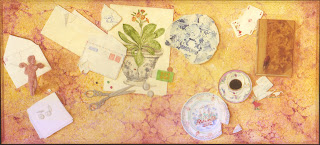This morning a carpenter and I discussed our latest project for the flat - to rebuild our master bedroom closets (I thought mine was full until I opened the Celt's ... !)
These closets flank a small hallway to the bathroom and years ago had been designed for the previous owner. And after six years of utter irritation I've decided finally improvements to the present situation need to be made: for example, shirts have to be taken from the dryer on one set of hangers then rehung on another set that hook into the so-called system installed forty years ago. It drives me crazy and it is a wonderful example of a solution looking for a problem.
What I need are two rows of simple rods that accept regular clothes hangers, one shelf at the top of the closet - for the life of me I cannot think why I need a shelf but apparently I do - and shoe storage. Beyond that, what do I need? Tie and belt storage? Both easily taken care of on the back of a door, as is a full-length mirror to check hems and seams, etc. Even the mirror is not really necessary, for I never look in a mirror to see if my outfit works - after being pulled, tightened, smoothed, brushed, rolled, given a hug and a kiss, being told it's all going to be alright, and sent on my way grousing about being trussed up like a Thanksgiving turkey, I don't really need to.
All of which has absolutely nothing to do with what I wanted to write about today. When the carpenter called I was in the middle of distributing today's mess around my work space, also known as the dining table, and it occurred to me as it has many times before that I need own space that I can close the door on when I'm done - my own home office.
It seems I have two choices: I can place the painted Provençal table you see here but which is really too small for laptop, books and scanner, in front of the library window - a geographical change rather than a real solution, or I can build a desk with drawers, data, and lighting within the closet in that same room.
Perhaps for resale purposes its not so sensible to reduce closet space but resale is not something that is going to happen any time soon, and isn't the point to make one's own place work for one rather than for some hypothetical future buyer - much in the way that the previous owner of our flat did when she had the much despised closet system installed? Undoubtedly, it worked for her, her clothing, and her maid.
The table top I painted over a number of weeks when we lived in Amsterdam. I found it relaxing to come home after work, sit by the windows in that lovely yellow room - windows that overlooked gardens hidden between the canal house and the mews and over which towered massive red beeches -and paint yet another talisman, as it now seems, of our lives.
The matchbox from the restaurant overlooking the Rockefeller skating rink holds two matches - we two on our first trip together to New York; ticket stubs from the original off-off-off-off-Broadway The Night Larry Kramer Kissed Me matinee we happened to walk by one afternoon (whoda thought it, we said, in New York, showing up at the box office and getting tickets right away?); the fragment of a blue-and-white plate dug up in front of our stoop when the city was burying cable; a birth announcement - the small pink ribbon showing it to be a girl; the goose girl and her geese brought back by the Celt from a trip to a Nurnberg Christmas market and which we still set out at during the Holidays; dregs of coffee in a demitasse, part of a harlequin set we use at dinner; the ladybug, or onzelieveheersbeestje as we knew it in Holland, that landed on the print of a blue-and-white pot holding a primula auricula; a handkerchief on which sits a pair of Persian silver and mother-of-pearl cufflinks, the surfaces painted with the most delightful of scenes straight out of an illuminated manuscript; three tiny dice from a Christmas cracker that rattle still in the same ceramic box I placed them in 25 years ago; a button; a terracotta cherub that hangs each holiday from the gilded frame of a Gustavian looking glass; playing cards (strange to say, for I have an aversion to gambling and will not play any card game) one of the Queen of Hearts, the other a torn Ace of Hearts - no symbolism there, I wanted to paint a piece of scotch-tape convincingly; an airmail envelope possibly from my grandmother; coins, scissors, and a broken and much-repaired dish given to me by a now long-dead friend; a newly-bought old copy of Death Comes For the Archbishop atop which sits a Devil's Coachhorse beetle.
I didn't see it then, but the strangest thing to me now is that there is so much damage, tearing, cracking, breaking, to the objects I painted on that table. And I realize damaged, cracked and broken things are still of value to me. The broken and repaired bowl, such a beauty, and for which I have the most tender feelings - not just in memory of the friend who when he was alive told such wonderful tales of his Jewish family all of whom were wiped out in the Holocaust, though that should be enough, perhaps - but I think because like much in my life it was broken and repaired, broken and repaired again, and which, for all its scars and its colors, remains a metaphor for the lovely life I have.
In Circles
2 days ago











































.JPG)













